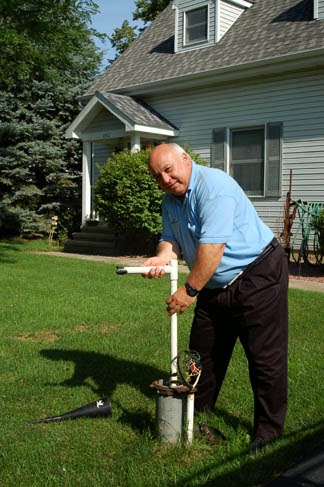There are many who don’t think that’s the case; they think they can get by chlorinating their own well without any difficulty. After all, what’s to it other than removing the well cap, removing the cap on the container of chlorine and pouring it into the well? Put the cap back on the well, and the seal up the chlorine container, if any chlorine remains, and – Tada – all done, right?
Not quite. You may get by that way for years. When friends come to visit, they’ll look at you in awe as you proudly proclaim, “I chlorinate my own well.” Some may be so impressed that they’ll ask you to come over and chlorinate their well, too.
The problem is that chlorinating a well isn’t quite that simple. If all you do is open the well and pour, you may later discover that you’ve created a costly headache that will come back to bite you.
The problem is that the pump and connectors don’t react real well to chlorine. If you need to replace a pump down the road sometime, your well technician is liable to look at you with a frown and say, “You chlorinated your own well, didn’t you?” That’s the moment when you’ll realize that there is more to chlorinating a well than open and pour.
Another question is when to chlorinate your well. Technically, you can chlorinate a well any time of the year. But, there are good times to chlorinate your well and there are not so good times. One not-so-good time is in the middle of winter. Why? Not only because it’s cold out and darn uncomfortable to play with water in that kind of weather, but also because, to do it properly, you’ll want to run your outside faucet after words to clear out any sediment the chlorine broke off the inside of the well.
If you’re planning to bill a skate pond in the backyard, that’s not a problem. On the other hand, maybe you’d rather not turn your yard into a skating rink.
It’s amazing how much sediment the chlorine can break loose in your well. If you don’t run it out the faucet outside, that sediment gets into your lines inside the house. You may suddenly find that you have clogged pipes.
Another reason to flush your well when chlorinating is if you have a septic system at your home. If not flushed, the chlorine could mount an attack on the bacteria in your septic tank. That bacteria is vital to breaking down waste.
Another problem, if you wait until winter to chlorinate your well is finding the well. That’s not, generally, a problem unless it’s covered by a foot or more of snow.
In any case, yes, you can chlorinate your own well and you can do it whenever you want. But, then again, you might just want to call in an expert.

